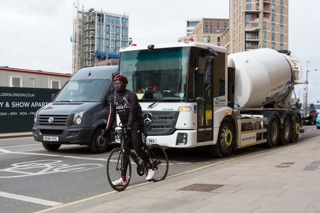Two-thirds of drivers (67%) say they find it difficult to get through some yellow box junctions without stopping, while 13% say this is the case for most they encounter, new research from the RAC suggests.
With councils outside London and Cardiff wanting additional powers to use cameras to catch drivers who stop in yellow box junctions, the survey highlights difficulties faced by some drivers.
Among those who claim it is difficult to drive through a yellow box junction without needing to stop, more than three-quarters (78%) think this is very often due to poor sequencing of traffic lights.
A third (32%) blame their infringement on the fact so many other drivers break the rules in this way that it forces them to do the same, while one in five (20%) say they are badly designed and 15% believe they are often used in the wrong places.
Currently, only local authorities in London and Cardiff are able to enforce yellow box junctions with cameras and issue penalty charge notices (PCNs), but many more councils in England and Wales would like to be able to use cameras to enforce these often troublesome and controversial junctions.
The rules are normally enforced by police, however declining officer numbers and the difficulty of catching offenders has resulted in little or no enforcement, leading to calls for a roll-out of camera enforcement elsewhere.
Asked whether councils across the country should be able to issue PCNs to any driver that comes to a standstill in one, more than a third (36%) of drivers surveyed by the RAC thought it was a good idea that would help prevent congestion at junctions.
Another 36% agreed they ought to have this power, but should limit enforcement only to problem junctions. A quarter (24%), however, are adamant local authorities should not have these powers.
But a majority of the 1,990 drivers questioned in the RAC survey would like to see a softer approach to enforcement if local authorities were able to use cameras to issue PCNs, with nearly two-thirds saying a warning letter should be sent in the first instance, followed by a fixed amount PCN for subsequent infringements.
A fifth (21%) think there should be a lower penalty charge for a first infringement, but a higher one for subsequent offences if caught again within a 12-month period. Just 13% claim it should be a fixed amount penalty charge notice, reduced for early payment, no matter how many times a driver gets caught.
In separate data seen by the RAC, Transport for London issued a total of 123,071 penalty charge notices (PCNs) in the last financial year for yellow box contraventions – up from 108,164 the year before.
The top location for yellow box contraventions was the exit of the Wandsworth fire station on West Hill where 16,707 PCNs were issued to drivers in the last financial year, followed by the fire station exit on Homerton High Street where 12,071 were issued to drivers.
The top five locations on TfL roads for yellow box contraventions from April 1, 2017, to March 31, 2018, were as follows:
| Location | PCNs issued |
| Wandsworth fire station exit on West Hill, SW18 | 16,707 |
| Homerton fire station exit on Homerton High Street | 12,701 |
| Hanger Lane / Ealing Village junction, W5 | 8,033 |
| Euston Road / Judd Street / Midland Road junction | 5,595 |
| Peckham High Street / Peckham bus station exit (east box) | 5,432 |
Under the Traffic Management Act 2004 local authorities in England and Wales could be allowed to enforce ‘moving traffic’ contraventions such as disregarding yellow box junction markings.
Despite a recommendation from the House of Commons Transport Committee seven years ago for councils to be given these powers by 2013, the Government said in 2015 it had no plans to activate them.
The Local Government Association, however, has called for them to be put into place nationally, arguing the police have largely ceased to enforce moving traffic offences since the act was introduced.
Scotland would have to introduce new legislation to do this as the country is not covered by the Traffic Management Act 2004.
RAC spokesman Simon Williams said: “If the Government was to grant local authorities the same powers that are already being used in London and Cardiff it’s highly likely we would see a massive rise in the number of drivers being issued penalty charge notices.”
The RAC is generally supportive of local authorities having the power to enforce yellow box junctions because of the value of local knowledge, but has concerns that it could lead to local authorities being inconsistent in their application of road traffic law.
Williams continued: “There is also a risk that cash-strapped authorities may see it as a lucrative revenue stream. To prevent this, we think warning letters for a first contravention would be appropriate.
“We therefore believe it is essential that every yellow box junction where a camera is installed is comprehensively tested to ensure it is easy to negotiate without stopping.”
A guide to yellow box junctions
Why do we have box junctions?
- Box junctions are used to keep traffic flowing by ensuring the road space is kept free for moving vehicles coming from different directions.
How do you drive in a box junction?
- You may enter a yellow box junction when your exit from it is clear and there is sufficient space on the other side for your vehicle to clear the box without stopping.
- You may only stop in a yellow box junction if you are turning right and are prevented from doing so by oncoming traffic or vehicles ahead of you are also turning right.
- If your exit is not clear and you are not turning right then no part of your vehicle should enter the yellow box.
- The principle and the rules are the same for a yellow box junction on a roundabout.
Remember: Blocking a yellow box junction means that everyone else gets blocked with you.
The rules around yellow box junctions are covered by rule 174 of the Highway Code.























Glenn Ewen - 22/11/2018 11:40
Don't understand why this would be expensive for fleets? It is a driver offence and surely dealt with in the same way as a parking fine. A bit more admin admittedly, but drivers should be paying lease company admin fees and vat as part of a recharge if any.